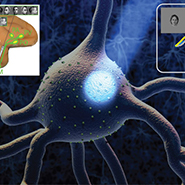Approach
Our team of theoreticians and neurophysiologists will investigate how neuronal circuits instantiate fundamental computations underlying intelligence. We will start with tasks involving visual recognition of objects, people, scenes and interactions among these. Our ability to selectively interpret an image and to generalize across large changes in low-level properties of the image constitutes a fundamental example of intelligent computations. We will be developing novel neurotechnologies to interrogate the activity of large neuronal ensembles; these efforts will transform our capability to interrogate neural circuits and will thus enable a direct empirical evaluation of theories of recognition. We will characterize the dynamics underlying recognition in multiple species, from rodents, to monkeys to humans, and across multiple scales, from neurons to neuronal ensembles, to local field potentials. A central problem in theories of vision involves describing how to combine exquisite selectivity with tolerance to object transformations. To shed light on this question, we will investigate how neural signals respond to image transformations including viewpoint changes, occlusion, clutter and others. We will consider progressively more complex tasks and challenges en route towards providing direct insights into biological solutions to the Center’s main challenges.
Integration
The efforts in Neural Circuits for Intelligence will benefit from interactions with all the other thrusts. As described above, all the neurophysiological experiments will be inspired by the theories in “Enabling Theory”. We will establish novel collaborative and interdisciplinary efforts to work with the researchers in Development of Intelligence, Vision and Language and Social Intelligence to provide neural insights that describe biological solutions to the questions about development, learning, social interactions and interactions between vision, action and language.

 Abstract thinking and complex problem solving constitute paradigmatic examples of computation emerging from interconnected neuronal circuits. The biological hardware represents the output of millions of years of evolution leading to neuronal circuits that provide fast, efficient, and fault-tolerant solutions to complex problems. Progress toward a quantitative understanding of emergent intelligent computations in cortical circuits faces several empirical challenges (e.g., simultaneous recording and analysis of large ensembles of neurons and their interactions), and theoretical challenges (e.g., mathematical synthesis and modeling of the neuronal ensemble activity). Our team of theoreticians and neurophysiologists is focused on systematic, novel, and integrative approaches to deciphering the neuronal circuits underlying intelligence. Understanding neuronal circuits that implement solutions to complex challenges is an essential part of scientific reductionism, leading to insights useful for developing intelligent machines.
Abstract thinking and complex problem solving constitute paradigmatic examples of computation emerging from interconnected neuronal circuits. The biological hardware represents the output of millions of years of evolution leading to neuronal circuits that provide fast, efficient, and fault-tolerant solutions to complex problems. Progress toward a quantitative understanding of emergent intelligent computations in cortical circuits faces several empirical challenges (e.g., simultaneous recording and analysis of large ensembles of neurons and their interactions), and theoretical challenges (e.g., mathematical synthesis and modeling of the neuronal ensemble activity). Our team of theoreticians and neurophysiologists is focused on systematic, novel, and integrative approaches to deciphering the neuronal circuits underlying intelligence. Understanding neuronal circuits that implement solutions to complex challenges is an essential part of scientific reductionism, leading to insights useful for developing intelligent machines.